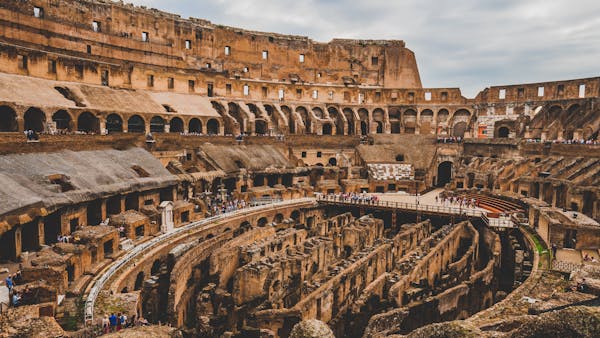The Jubilee 2025 in Rome promises to be a profound journey into the city’s spiritual heritage. This unique event invites pilgrims and seekers alike to explore sacred sites, connect with rich traditions, and experience renewal. From architectural marvels to hidden gems, unlocking these treasures can deepen one’s faith and provide transformative encounters. Discover how to make the most of this extraordinary spiritual opportunity.
Understanding the Spiritual Significance of Jubilee 2025
The Holy Year of Jubilee, celebrated every 25 years, holds profound meaning within the Catholic faith. Rooted in the biblical concept of spiritual renewal and forgiveness, it is a time for believers to reflect on their faith, embark on pilgrimages, and seek divine grace. Pilgrims gather from across the globe, united in their quest for hope, forgiveness, and redemption. The upcoming Jubilee in 2025 is guided by the motto “Peregrinantes in Spem” or “Pilgrims in Hope,” highlighting the importance of solidarity and resilience in navigating life’s challenges. These reflections find a deeper resonance within the tangible symbolism captured by the Jubilee logo—a pilgrimage both spiritual and communal, reminding believers of faith’s anchoring strength amid turbulent times. Here, exploring experiences to enrich your Rome Jubilee 2025 visit becomes indispensable in fully immersing oneself in this profound journey.
Topic to read : Discover must-visit harry potter spots and experiences in london
The Historical and Evolving Essence of the Jubilee
The Jubilee tradition began in 1300 under Pope Boniface VIII as a formal declaration of indulgence and an invitation to spiritual enrichment. While initially confined to the city of Rome, it has evolved, encompassing diverse themes geared toward addressing modern-day spiritual, social, and cultural challenges. Over the centuries, Jubilees have impacted communities not only religiously but also socially by fostering philanthropy, community engagement, and cultural exchange. For the 2025 Jubilee, the emphasis on inclusivity is further amplified, as numerous activities—from prayer groups to cultural events—encourage participation across all demographics.
Communion and Collective Faith
The Jubilee’s essence is profoundly communal, emphasizing shared faith and united experiences. Key spiritual practices during the Jubilee, such as visiting the four principal basilicas of Rome, including St. Peter’s Basilica, highlight the importance of collective worship. The symbolic act of crossing the Holy Door signifies a personal and collective step toward grace and renewal. Community engagement is further seen in opportunities like volunteering, which not only draws participants closer to spiritual traditions but also enhances their understanding of faith’s transformative impact on society. Jubilee 2025 is poised to host millions of pilgrims who will together shape and enhance this extraordinary chapter of communal spirituality.
Also read : Uncovering Wales” Rich Coal Mining Heritage: Top Strategies for an Engaging Exploration
Key Historical Landmarks and Pilgrimage Sites in Rome
Major Pilgrimage Routes and Their Significance
Rome’s deeply entrenched history makes it not only a city of grandeur and art but also a revered destination for spiritual pilgrimages. The Holy Year of Jubilee 2025 amplifies this symbolism, with pilgrims often tracing routes steeped in faith and tradition, such as the Via Francigena, an ancient path leading to St. Peter’s Basilica, symbolizing a pathway of renewal and hope. As the main artery for pilgrims arriving in Rome, these routes embody centuries of devotion, guiding participants to sacred sites like the Holy Door of St. Peter’s Basilica, which will open December 25, 2024, marking the official start of the Jubilee.
Other notable pilgrimage routes include the Seven Churches Walk, pioneered by St. Philip Neri in the 16th century. Embracing this path, which incorporates iconic sites like San Giovanni in Laterano and Santa Maria Maggiore, allows participants to immerse deeply in the spiritual heritage of the city while fostering personal introspection.
Prominent Cathedrals and Their Artistic Heritage
Rome’s cathedrals stand as unparalleled examples of faith meeting artistry. Within their walls, visitors uncover treasures that stretch beyond religion into the very core of humanity’s creative accomplishments. St. Peter’s Basilica, an architectural marvel, is renowned for Michelangelo’s Pietà and Bernini’s towering Baldachin. This site does more than celebrate beauty; it underscores the intersection of religion and high art.
Other cathedrals, like San Giovanni in Laterano, the Papal Cathedral of Rome, serve a pivotal spiritual role. Known as the Cathedral of the Pope, its ancient mosaics and ornate ceilings project not just a historical legacy but also vivid themes of hope and renewal, pivotal in the Jubilee Year. Meanwhile, Santa Maria Maggiore boasts unparalleled frescoes detailing biblical stories, designed to inspire and teach believers through vibrant visuals.
Important Sacred Sites and Their Role in the Jubilee Experience
The Holy Door Pilgrimage serves as the heart of Jubilee spirituality, inviting pilgrims to cross its threshold for divine grace. Located within iconic basilicas—such as the Basilica of St. Paul Outside the Walls—these symbolic doors are cyclical opportunities for spiritual cleansing.
Beyond the pilgrimage route, other sacred sites like the Sanctuary of Divine Love reflect the communal aspect of Catholic devotion. From intimate chapels to towering sanctuaries, these places offer quiet moments of prayer, connecting visitors to Rome’s profound spiritual heritage.
Through their historical and religious contexts, these landmarks tether the past with the present, offering not just religious observance but transformative spiritual engagement.
Preparing for the Jubilee Experience in Rome
Registration and Logistics for Pilgrims
Anticipating the grandeur of the Jubilee 2025, proper planning becomes essential to fully embrace the spiritual opportunities while navigating the logistical challenges. For individuals or groups planning a pilgrimage, online registration is mandatory through the official Jubilee platform. This ensures structured timings and access, particularly for visiting sacred sites such as the Holy Door of St. Peter’s Basilica, which will open its threshold to pilgrims starting December 25, 2024. Key details, like arriving at Piazza Pia—strategically located between Castel Sant’Angelo and Via della Conciliazione—at pre-booked times, are integral to managing the large influx of visitors expected during the event.
Since Rome anticipates hosting approximately 35 million pilgrims throughout the Jubilee Year, early reservations for accommodations and transportation are highly advisable. Crowds at leading historical and pilgrimage landmarks such as the Vatican Museums, Sistine Chapel, and St. Peter’s Basilica are expected to peak. Pre-arranged package tours can be a strong consideration for those seeking seamless travel logistics, combining secure bookings, guided itineraries, and access to key sites. With faith at the heart of this experience, practical details should complement the spiritual journey without overshadowing its significance.
Key Events and Activities During the Jubilee Year
The Jubilee 2025 will be marked by a vibrant calendar of themed events, offering all faithful unforgettable moments of reflection, celebration, and renewal. Central to these activities is the Holy Door pilgrimage, where crossing the threshold symbolizes a step toward forgiveness and grace. Alongside this, attendees can immerse themselves in unique cultural and spiritual events, including the Jubilee of Artists and the Jubilee of Youth, each highlighting intertwined aspects of faith and creativity.
Throughout Rome, churches such as San Salvatore in Lauro and Santa Maria in Vallicella will host prayers, confessions, and activities fostering community connections. Beyond Vatican City, sacred sites like the Church of Santa Maria del Suffragio and the Sanctuary of Divine Love open further pathways for spiritual reflection away from the central bustle. Pilgrims can also partake in specially curated exhibitions, concerts, and guided explorations of Rome’s unparalleled historical landmarks. These events aim to bridge the ancient and contemporary, underscoring the enduring role of Catholic heritage in shaping spiritual and cultural identity.
Community Engagement and Volunteer Opportunities
One of the most fulfilling ways to actively immerse oneself in the Jubilee experience is through volunteering. From assisting pilgrims at key sites to organizing community-driven events, volunteer programs are a gateway not only to service but also to spiritual growth and fraternity. The emphasis on engagement reflects the Jubilee logo’s symbolism—figures representing humanity, solidarity, and unity, further drawn toward the hope of the cross.
Volunteers will play essential roles during the event—from logistical support at crowded venues to ensuring accessibility for international visitors. For locals, these opportunities seed a sense of responsibility toward their community, while international participants foster a stronger global faith connection. Jubilee authority resources underscore the themes of hope and renewal, encouraging both active and contemplative participation.
Such efforts not only streamline the pilgrimage experience for millions but enhance the Jubilee’s message of building lasting ties through compassion and shared faith. As attendees, embracing these facets ensures the Jubilee year becomes more than an event—it becomes a milestone of personal and collective transformation.











